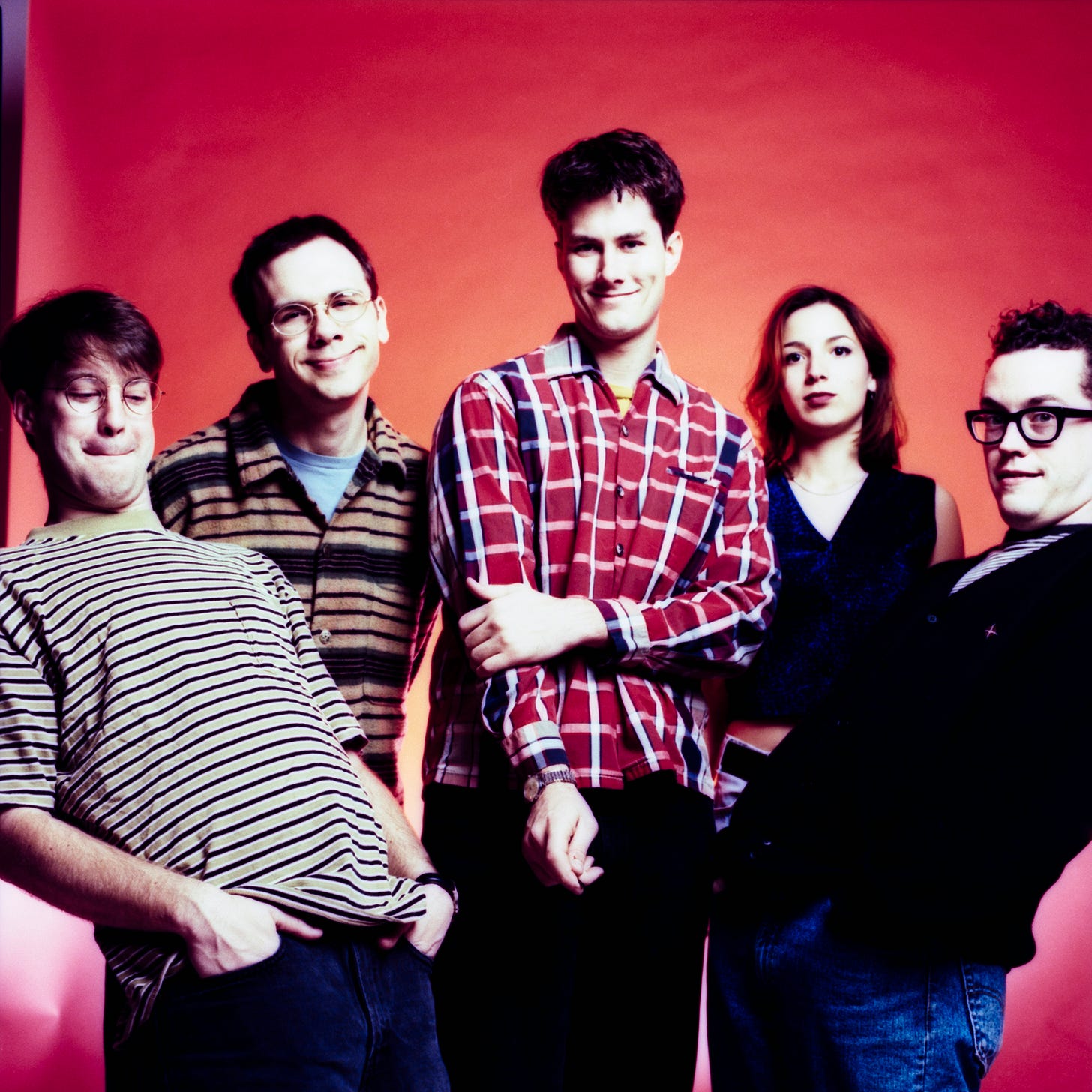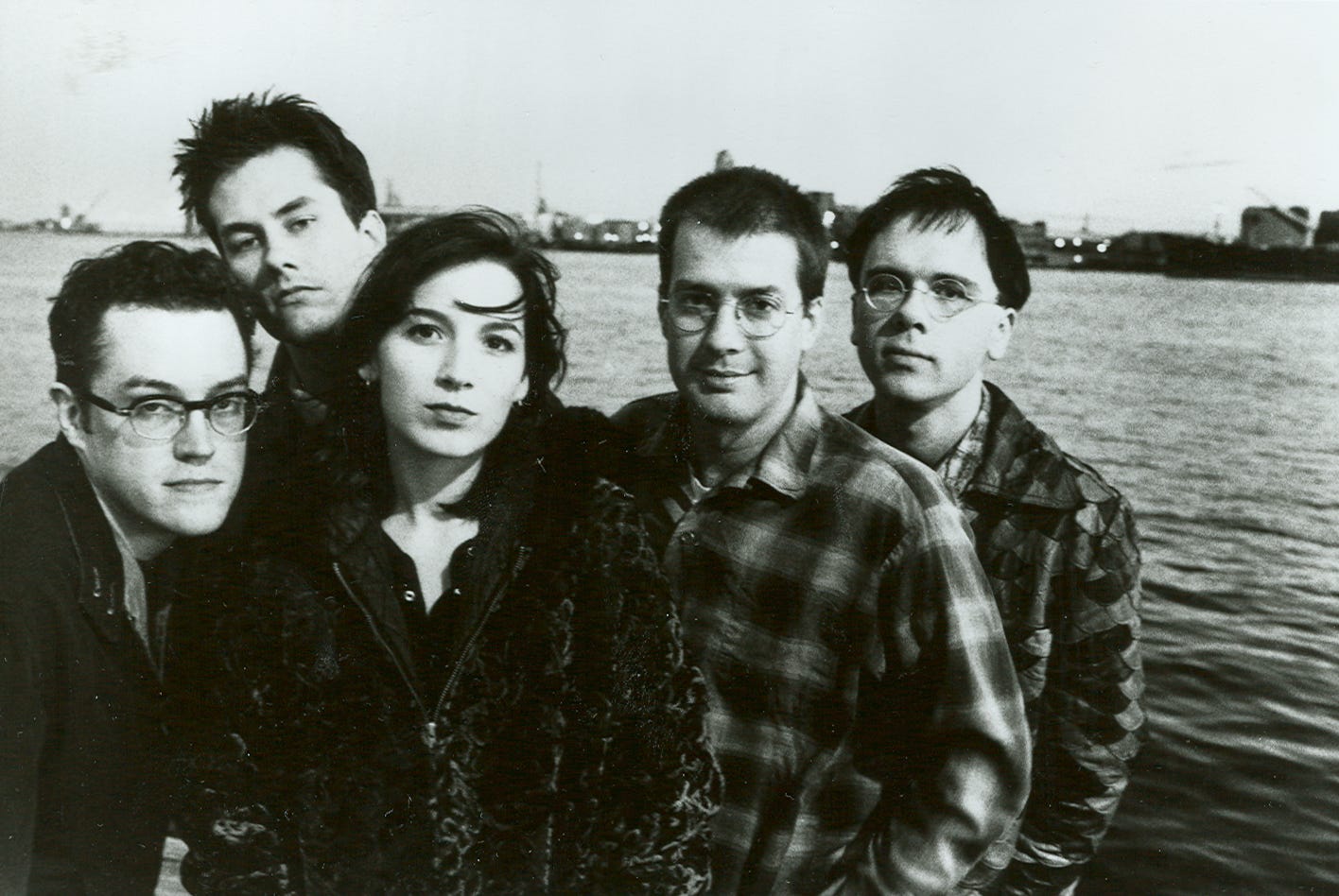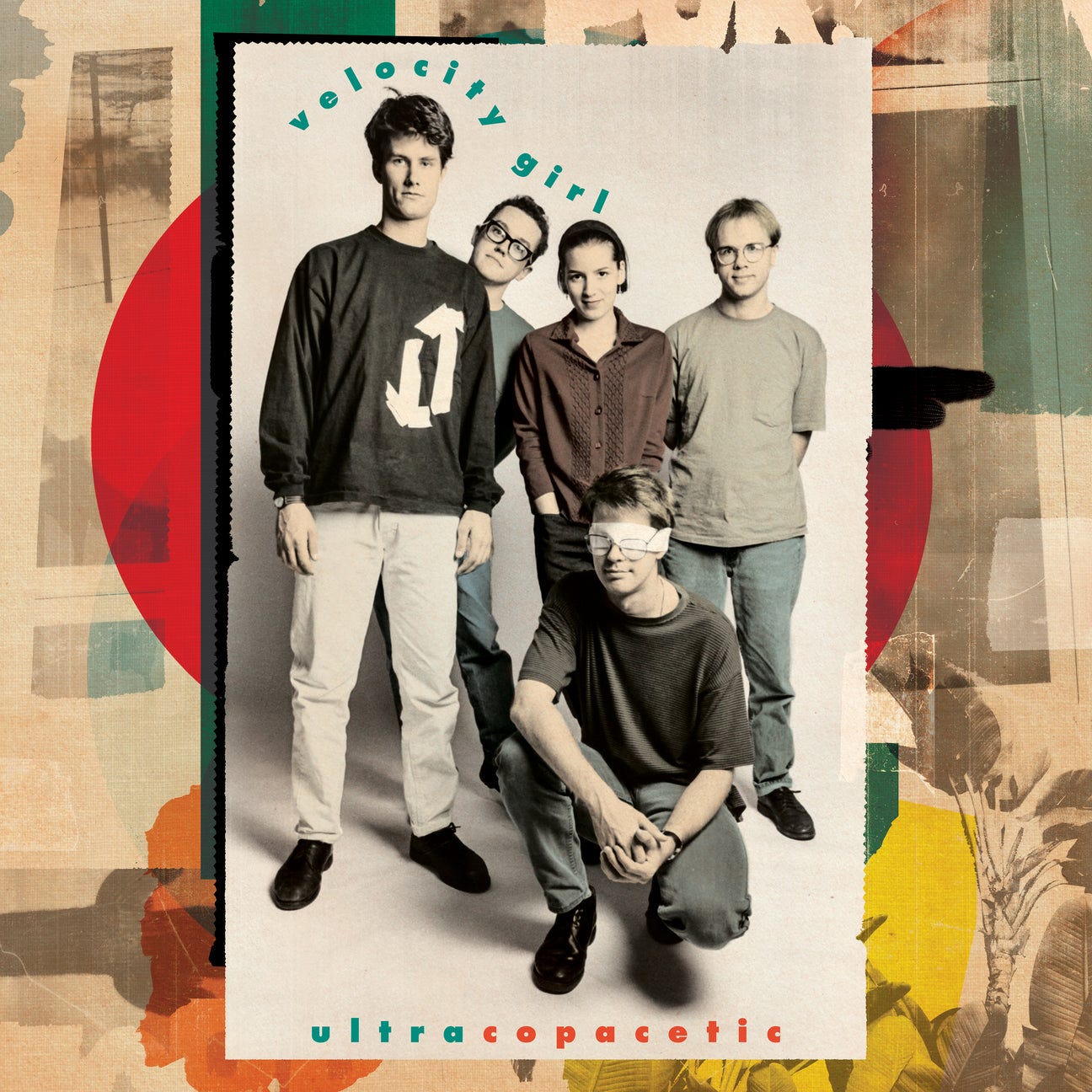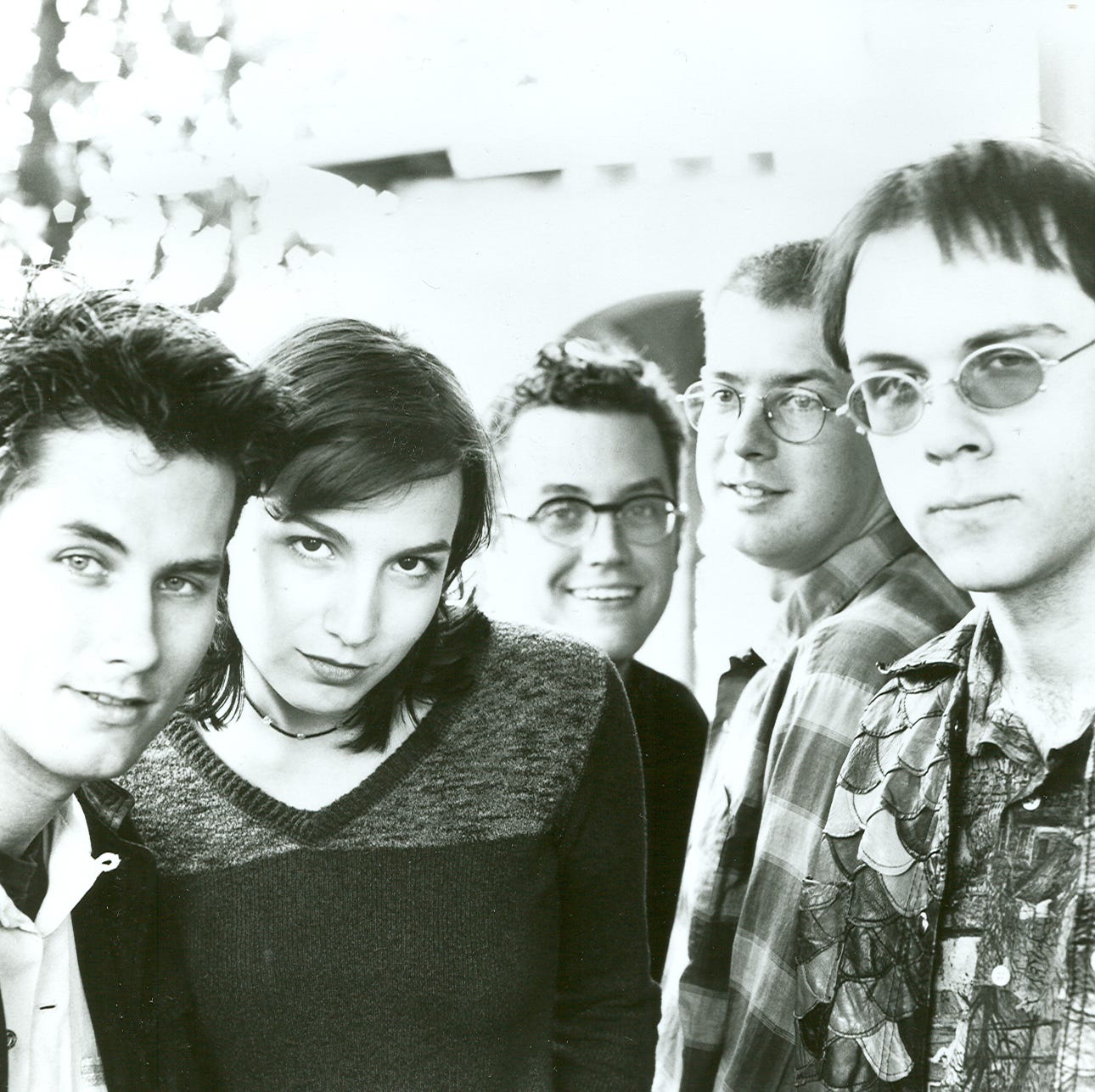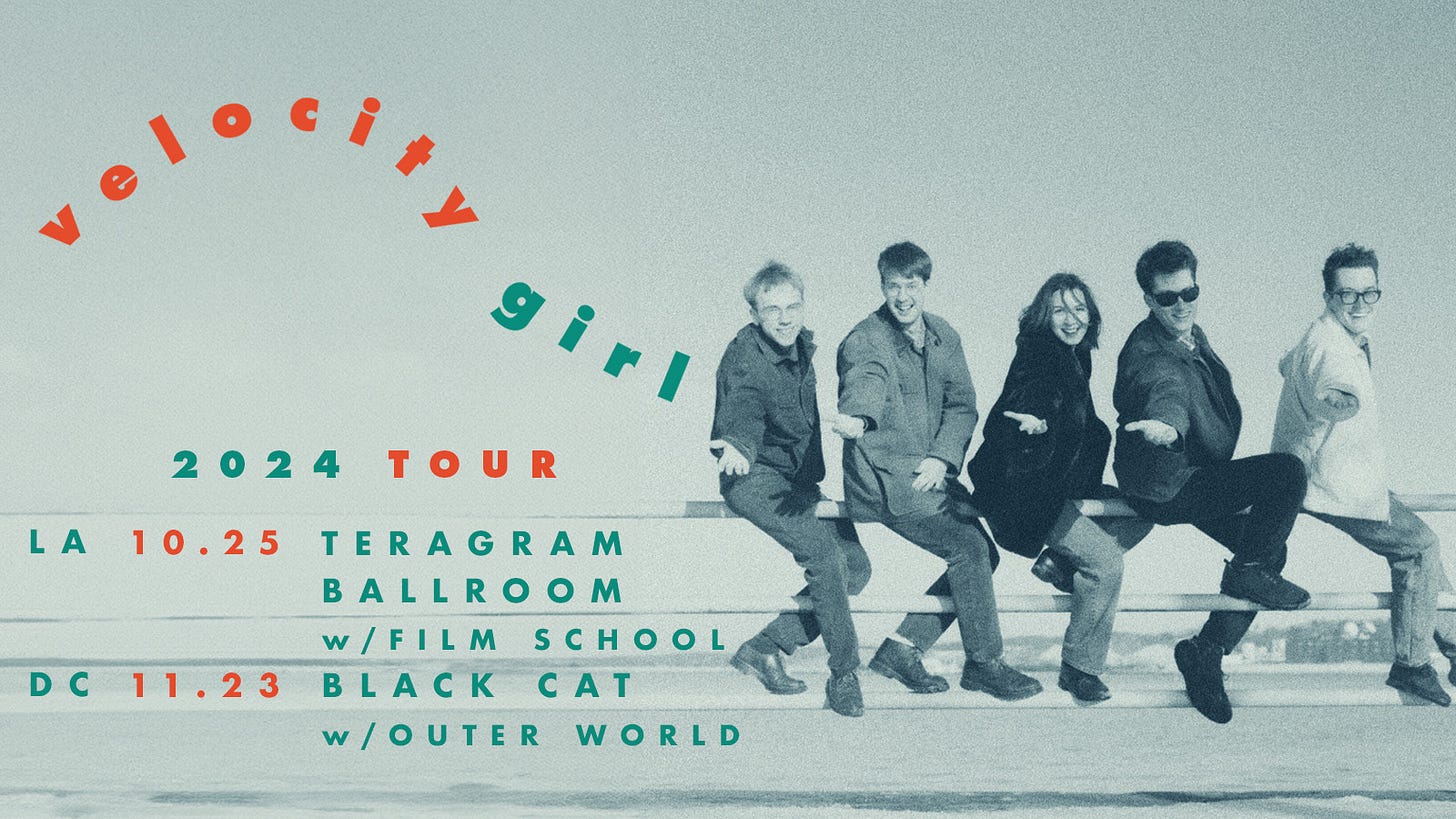An interview with Velocity Girl
Archie Moore and Sarah Shannon talk about the legendary indie pop band's reunion, how much better their debut album sounds after remixing it, and originally wanting to be a shoegaze act.
I came rather late to Velocity Girl. I remember reading profiles on them in magazines, seeing their videos on MuchMusic and owning a cassette copy of their second album, ¡Simpatico!, but for quite a while they were one of my most shameful blindspots of ‘90s indie rock. Then about ten years ago I corrected the ship and tracked down all three of their albums on vinyl and read whatever I could find about them.
Just on paper alone Velocity Girl had a lot to offer someone like me. Aside from releasing music on primo labels like Slumberland and Sub Pop, they featured two members -Archie Moore and Brian Nelson - from the great, yet short-lived indie pop outfit Black Tambourine; they took their name from the jangly B-side Primal Scream donated to the essential UK indie pop compilation, NME’s C86 tape; and original vocalist Bridget Cross left to join Mark Robinson in Unrest. That is some impressive pedigree.
Sarah Shannon would join Moore, Nelson, Kelly Riles and Jim Spellman in 1991 and become their voice from that moment forward. Velocity Girl signed to Sub Pop in 1992, during the label’s second wave, just as Nirvana was becoming the biggest rock band on Earth, bands like Mudhoney, Afghan Whigs and Tad signed to majors, and the roster featured promising newcomers like Sebadoh, Eric’s Trip, Seaweed and Hazel.Velocity Girl’s debut album, 1993’s Copacetic, would is said to have become the best-selling album next to Nirvana’s Bleach for a short time. (This is not a confirmed fact, but some excellent folk lore.) Balancing shoegaze’s crashing waves of distortion with indie pop’s chiming melodies, Velocity Girl offered a distinct sound to the indie rock set in search of the next great band. Shannon’s vocals were the icing on the cake, with a range that could command a song with confidence or levitate to a dreamy falsetto, the result of being a trained opera singer.
Of course, as they became a tighter band with their subsequent albums, 1994’s ¡Simpatico! and 1996’s Gilded Stars And Zealous Hearts, Velocity Girl focused more on a cleaning up their sound and honing their melodies. The band parted ways in 1996, as real life responsibilities crept into the members’ lives, but things always seemed in the cards for the band to resurface. A one-off show in 2002 at the Black Cat in D.C., followed by another one for charity 21 years later indicated relations were still good in the band.
And now they’re back, playing a few shows and releasing UltraCopacetic (Copacetic Remixed and Expanded), an official reissue of their debut album that comes remixed, remastered, and expanded with new liner notes and an additional LP of singles, outtakes, and the band’s 1993 Peel Session. While no official word has been given, hopefully it’s the start of more things to come from this beloved band.
While you’re ordering a copy of UltraCopacetic, also check out the band’s merch store with an assortment of reprinted classic tees.
So who initiated the reunion?
Archie Moore: Over the decades we've gotten occasional requests from people to play a reunion show or some sort of little indie festival. Not big festivals or anything like that. And for the longest time we just automatically didn't really consider it for logistical reasons, but also I think it didn't really feel like there was too much of a demand. And then I think this time maybe there was a little bit of an existential crisis. We all had teenagers that were finally old enough to actually witness us playing and we realized it would probably be the last time that would be able to happen. We're also old enough so that it really didn't matter whether it was cool to do a reunion show or not.
Had had you guys kept in touch all these years?
Moore: To different degrees, yeah.
Sarah Shannon: Not as well as I should have. I'll go ahead and put myself on the line for that one. I haven't kept in the best touch, but as best as we could.
Moore: To be fair Sarah lives 3,000 miles away from the rest of us. The men of Velocity Girl are all in the Washington, D.C. area and I think different configurations of us have kept in touch to different degrees over the years, but there's never been like a cold silence. There wasn't a bad scene or anything between us.
I've never actually read what led to the band breaking up in 1996. Had Velocity Girl just run its course?
Shannon: It was a couple of different things. I got married and moved to Seattle, so geographically that was tricky. I was thinking I could make it work and then Brian decided financially it wasn't working for him. He had mentioned having to ask his dad for money for the first time. So I think he was ready to settle down with his serious girlfriend, who soon became his fiancée. I had a husband.
So how did it feel last year when you reunited for a show and played those songs again?
Shannon: I would say it was one of the best feelings of my life. That sounds pretty over-the-top, but it's true. Just remembering the songs… I kind of had forgotten all of them. I don't really like to listen to anything that has my voice on it.
Moore: She is not exaggerating. We did the Zoom practices at first, when she was still in Seattle, and she was like, “Is that our song? That's really good! What's that called?”
Shannon: Yeah, becoming reintroduced to these songs and spending time with the guys and hearing them sounding really good made me want to step up and meet them where they were at. And just remembering how great the songs were, how fun it was to play together, and the stage experience… I don't think I expected that audience. I didn't expect that amount of enthusiasm. We were sounding good, I think better than ever, and that was fun. I was really nervous, but I decided to channel my nerves into performing the best I could and it felt freakin’ amazing.
Looking back on the early days, the band first started as a as a hobby. At what point did you realize Velocity Girl could be like a full-time gig?
Moore: I would say it was several years into us just kind of screwing around, so probably about 1992 when we were asked to do a Sub Pop Single of the Month release. By that point we had started gigging around a lot, but I'd say up until we were signed, I think we all agreed that the unspoken plan was that we would just record and self-release an album via Slumberland Records, which had put out our singles, and then we would probably fizzle out. But we wanted to document our first batch of songs after the 7” singles we had done. But the signing kind of pushed us into a different headspace, where we thought, “We can maybe quit our jobs to go and support a record.” So late 1992 is when I would probably put a time on it.
I spoke to Sloan recently, and they were interested in signing to Sub Pop because it was more in line with their tastes, but they ended up with Geffen. How important was it for Velocity Girl to sign with a label like Sub Pop? They definitely had quite a bit of clout at the time.
Shannon: They had clout and they had the indie rock chops. I can't remember any of the conversations, of course, specifically about “Do we go with this person or that person?” But correct me if I'm wrong, Archie, my belief is we would have only had one record if we had signed with somebody like Geffen?
Moore: Yep. Do you remember Silvertone Records? The American branch of Silvertone was pushing for us, and it was kind of between them and Sub Pop for a while. One other thing with Sub Pop was that we had a trusted friend there named Joyce Linehan, who had just effectively started the East Coast wing of Sub Pop. She probably would have very happily signed Sloan because Joyce was cuckoo for the Halifax scene.
Yeah, Sloan mentioned Joyce.
Moore: I think that she managed to get this EP out that had four different Halifax bands.
Right, Never Mind The Molluscs!
Moore: So that was all Joyce. We had met her and maybe crashed at her place a few times on our little East Coast excursions, and I think she was the one who got us the a Single of the Month record. So we loved her and completely trusted her.
Shannon: If I recall the guy from Silvertone, Michael Tedesco, he was a nice guy, too.
Moore: Oh, yeah, I remember we crashed at his place too.
But you dodged a bullet there because Stone Roses were on Silvertone in the UK and they had a hell of a time trying to get the rights back to their music. They went to court and it took years.
Moore: And this would have been the U.S. attempt at a branch. I don't even know what records they ended up putting out here. I think maybe Sonic Boom’s first record, Spectrum and then the Spectrum records came out?
Obviously in the ’80s and ‘90s, D.C. was known for its punk, hardcore and post-hardcore scene. Years ago, Archie you said that “American pop-song-oriented indie stuff” was pretty much absent in the D.C. scene back then. How did you feel playing that kind of music in a sea of punk bands?
Moore: I think the most important thing is that it was a very supportive scene, even if we and a few other bands were in a different part of the playground. It was a different thing that we were doing but we would still end up on bills with post-hardcore bands like Jawbox. Somehow we never played with Unrest at the time, who are actually not too dissimilar, but we played with Severin and Jawbox, bands like that. We were friends with all those people and enjoyed the shows and everything.
To what I was saying at the time, I think our whole our headspace at the time was that we identified more with the International Pop Underground or something like that, where we looked to some bands in Providence and Boston that we were friends with. We also idolized K Records and stuff like that, and a bunch of stuff in the UK. I don't think we viewed ourselves as part of any provincial or local scene until we became friends with Tsunami and few other local bands. But we certainly enjoyed being part of a D.C. music culture that was very much dominated at the time by post-hardcore.
Whenever I read about Copacetic, a lot of writers like to list shoegaze as an influence. I can hear it on half of the album, but it seemed like you were trying to do something different from a lot of the shoegaze acts. How much of that scene in the UK influenced the type of songs you were trying to write?
Moore: Mind if I answer this one, Sarah?
Shannon: You go ahead, but I'm gonna make a little admission here, which I've probably admitted elsewhere. At the time I was not up on that music when I joined the band. I knew nothing about the those bands. I was listening to Fishbone and Trouble Funk. So I got an education.
Moore: So we started off as The Gotterdemocrats. Kelly and I are the only members that stayed when the name changed to Velocity Girl. We were very much, from the name to the sound, looking to a lot of the pre-shoegaze stuff, around 1988 when My Bloody Valentine had put out “You Made Me Realise.” We were really into the fizzier side of C86, bands like The Primitives and Shop Assistants. So the noisy pop that was coming out of the UK was huge with us. But then by the time we were doing songs for Copacetic, we had a lot of those songs before the “s-word,” as I call it, even existed. We were explicitly informed by Lush and Ride and definitely My Bloody Valentine. We really did identify with that and part of the purpose of the new mix of the record was to give that context. This is sort of the intended history of that record, and I think that the new mix is, like you said, it's not the entire record that has that sound, but the songs that do have it become a little bit more explicit with the new versions.
But the short answer is we didn't call ourselves a shoegaze band, but were into the really scrappy, I call it post-“You Made Me Realise” end of shoegaze. We were never influenced by Slowdive or that smooth chorus pedal, ethereal guitar sound.
I assumed it was more an extension of what you were doing before in Black Tambourine, which had a similar sound with noisy guitars, than what was going on in the UK.
Moore: But Black Tambourine had very much the same influences. It's funny, a lot of times bands will have placeholder names when you're practicing and the songs would be called like “Lush Song” or “Pale Saints Song” - that was Black Tambourine. Even if it didn't necessarily come across that way, that's where our heads were at. It was probably just our lack of ability that gave it a scrappier, more American sound.
There’s a lot more distortion on Copacetic than the subsequent records. Was that just a sign of the band developing its sound on ¡Simpatico! and Gilded Stars And Zealous Hearts?
Shannon: I think so. I think it was establishing and developing, but also our producer John Porter, who had worked with The Smiths, and getting better as musicians, feeling more confident.
Moore: Yeah and that can't be stressed enough because when we were writing the batch of songs after Copacetic, I don't think we had ever discussed cleaning up the sound or anything like that. It just sort of happened mostly in the studio. I think we were fully intending for some of the songs to still have that kind of crumbly, distorted guitar but then we were confident enough to trust the process and the guiding hand of a producer that time around. We let him turn the gain knob down a little bit on the guitars.
You recorded Copacetic with Bob Weston, who is an absolute legend. What did he bring to the record?
Moore: We met him and it was the same thing as with Joyce, where we met somebody in our early days who expressed interest in us and was super cool and that we trusted and he did the single for “Crazy Town.” We did that in a weekend in Pennsylvania and had a great experience. Bob was in the fucking Volcano Suns! He was cool and there was no way we were gonna think of somebody else when it was time to do our first record. It was a no-brainer for us. Bob was essentially making his first album as an engineer and we were making our first album as a band. We probably needed a producer in the room as well. I don't know if we had any budget that would have allowed that though.
Looking back on it now, having worked with John on ¡Simpatico!, do you think a producer could have done more for Copacetic?
Moore: Sorry, Sarah, I'm not trying to hog all the answers.
Shannon: No, you're fine. You're definitely the better person to speak to this stuff.
Moore: Again the reason we came back to this record is that some people in the band, almost right off the bat, felt like this isn't the record we thought we were making. To get back to the previous answer I gave, we wanted it to sound more like the British records we were listening to, compressed, sparkling, somewhat mildly psychedelic in a noisy pop way, a shoegaze-adjacent record. I don't think that necessarily came across, even though that had probably come across on our previous singles. So I think some people may have thought that the way the record came out was a statement and I think within the band it was regarded as “we whiffed it.”
So for somebody like myself who has listened to that record for years, what should I be trying to hear on the remixed version?
Moore: I think one of the big things is the drums throughout are gonna sound more like drums on a stylized new wave or post-punk record. Part of Bob's specialty was this ultra-dynamic… you know, like the Albini aesthetic of recording something as it is, moving the mics around the room until it sounds good. That worked really well with all of those American post-Slint bands of the early ’90s that were really stop on a dime, shit-hot musicians. For us, we were not a tight band basically, and it just sounded kind of wild and uncontrolled on our records. Compressing the drums was a major thing on this record, as well as adding some reverb to the guitars and things like that. All things that again, to put it in an embarrassing context, things that I was hearing on my favourite British records at the time. So my goal with this reissue is that people will hear from the first song “Pretty Sister,” once the band comes in after the little guitar intro, my intention was for people to go, “Oh, it's that kind of record!” It's not the Copacetic you heard before, it’s supposed to be this fake shoegaze record.
Shannon: I don't know if you know this either, but Archie was the one who remixed everything and in copious detail, inch by inch, little sound by little sound. He reconfigured everything. You are uniquely positioned to do so as a music engineer at a recording studio.
Moore: That also meant we could do it for free and we could take months to do it. I could do it after work or decide I wanted to not do something after work and take a break. So yeah, it took a toll.
Shannon: I think you were working your ass off diving into the minutia.
How does the new version sound to you, Sarah?
Shannon: It sounds great. I love the way it sounds. Like I said, I really didn't listen to the album. I maybe only listened to Copacetic once after we recorded it. It's deeply uncomfortable for me to hear my own voice. But listening to it now, I love it. It shines.
Moore: Part of the problem with doing this 30 years after the fact is that there's a good chance that people who are gonna listen to it have not listened to the album in many years, but I'm hoping that for the people who have listened recently or who remember what it sounds like, this is conspicuously different. I'm hoping that it's sort of an aha moment, where people go, “Oh, right The shoegaze thing kind of makes sense now.”
I don't know if either of you are aware of this but shoegaze is one of the hottest musical trends right now. I keep talking about it with other bands. Gen-Z loves it and it’s all over TikTok.
Moore: It’s insane. Maybe five years ago, I saw this post online that I had to jokingly repost on Facebook, but I swear to God it was an article literally titled “The Top 50 Shoegaze Albums of the First Half of 2016.” I read that and I was thinking, “Oh my god, in my head there are only ten classic shoegaze albums in existence and they're all from 1991 or 1992!”
Shannon: Sorry, is there any current shoegaze music?
There's quite a bit, but it a lot of it doesn't sound anything like what those bands were doing in the ’90s. A lot of it just sounds like heavy alternative rock. Like if you use certain pedals people consider your music to be shoegaze. There is some confusion over what it actually is.
Moore: There's some confusion and the same thing has happened with indie pop, which to me had a very specific meaning in the mid-’80s to say the 2000s, and now it's sort of a NPR kind of lifestyle choice. Now there's a heavy R&B vibe to a lot of what's called indie pop. So the terms just mean different things than they did before. But Cam, I'm sure you know about this, but Slowdive are so popular now that they've transcended their shoegaze icon status so they're now firmly entrenched in the world of touring 3,000 seat venues several times a year. And then our friends the Swirlies, who I absolutely love, they have a total Gen-Z fan base now too. I saw them at a place in D.C. and usually the shows I go to now are full of a sea of silver or white receding hairlines, and it was only half that at the Swirlies show. The other half was long-haired young kids.
Shannon: That's interesting. I’m a total ignoramus on this resurgence. Is there anything new that you like?
For sure, I listen to a lot of those new bands, whether I agree with them being shoegaze or not. How about you, Archie?
Moore: I listen to a lot of it and right now nothing's coming to mind, but Sarah it's ubiquitous enough that the new Taylor Swift album has at least one post-shoegaze song on it that I'm pretty sure the guy from The National probably was the sonic guide on it. There’s a chorus droning bass lead that's straight off of Disintegration by The Cure or a Slowdive record.
Shannon: Oh, I can't wait! I haven't listened to the whole thing.
Moore: It's really good!
I've seen her on some Spotify shoegaze playlists. It's kind of wild.
Moore: Yeah, so there's some context. The biggest artist in the world is into it.
You’ve also changed the album cover for the reissue. Is that about giving it a fresh, new look to go with the remix?
Shannon: Yeah, new look with the remix. I think I'm allowed to say this, but none of us were really super keen on the first cover.
Moore: Okay so, like the mix, maybe this is an extremely uncool attitude to have in rock music, but it's sort of a correction in general. And also it is an expanded version of the record and we tried to point to that obviously. The cover image is from the Sub Pop promotional poster from the original release, colourized with the same curving font and everything like that. But again, we just didn't know what we were doing and now we figure we can make it different. We're not interested in being cool. I know for a fact a lot of people in general are down on the idea of remixed records and things like that. So I think part of our idea is that none of that matters to us! We want to make something that we can look at and enjoy and feel good about.
For quite a while Copacetic was the second best-selling album in Sub Pop history behind only Nirvana’s Bleach. Those are some legit bragging rights you had there!
Shannon: So that was a talking point that [former Sub Pop publicist] Nils Bernstein gave us and I think that may not have been true?
Moore: I've always assumed that was in the [one-time salesperson, now CEO of Sub Pop] Megan Jasper zone of creatively fucking with people. Because I always felt like there's no fucking way we sold more records than Mudhoney’s Superfuzz Bigmuff and stuff like that. But who knows? And certainly if that was ever true about our record it was not for long. I mean at this point Sub Pop has had The Shins and The Postal Service and a million bands that may have gone into the six-digit sales, which we never approached.
One thing I love about Velocity Girl is that you were one of Sassy’s Cute Bands, but you also released a 7” single with the magazine. That’s so cool! I imagine you were quite proud of that.
Shannon: I love magazines. I love fashion. To have a single with a fashion magazine was a big deal for me. But honestly, I can't remember what it sounded like.
Moore: That song [“Crawl”] was from the first or second day we met Bob. He had recorded it at WMBR. That whole Sassy record was more genius Sub Pop promotion. It was Velocity Girl, Codeine, Sebadoh and Beat Happening.
What can you tell me about the singles compilation you have coming out on Slumberland?
Moore: It's basically going to be the singles comp we did with Slumberland with the blue and white wavy lines and rocket ship on the first side, which comprises both versions of the Australian and a U.S. edition of our first single when Bridget Cross was our singer. And then both sides of the “Forgotten Favorite” single. Then the second side of the record is going to have two unreleased songs, one of which is a Jam cover that we recorded our first session with Sarah. Basically it's going to have the two songs we recorded the first time we went into a session with Sarah. Both of those were unreleased. And then it's going to have our Merge single, the first mix we did of our Sub Pop Single of the Month and the Beat Happening cover we did. I guess that might be it. So it's twice as long as the original singles compilation and some of it is unreleased. Most of it is on vinyl for the first time ever. And not to be geeky about it, but one of the really exciting things about this release is that this stuff has never been on streaming before.
When we were hunting for the master tapes of Copacetic, Jim found analog masters of all of the early stuff, so this record that's coming out should have better sources than the original singles did. They were on DAT, which was at the time a very convenient format that we thought was cool, but ended up not sounding nearly as good as the quarter-inch mix down tapes we found.
Oh, and this comp will be released by Slumberland.
I read that you’re also doing a 10” edition of your Peel Sessions? That label Precious Recordings has so many great releases under their belt.
Moore: So we were all set up to do that with Precious and then when the Ultra Copacetic logistics were being worked out, we realized that it didn't make any sense to be releasing three records essentially at the same time. Also we needed material to put on a second disc for the Ultra Copacetic release. You know, we only had four songs in addition to the album. So it's not coming out on Precious. I absolutely love Precious and just recently they've announced Peel Sessions from like three of my favourite bands, so it really would have been nice to have been part of that family.
The thing about the reissue is that it really does nicely wrap up the entire noisy era that we had on Sub Pop. Like, every everything we did for Sub Pop while we were a noisy kind of pop band is on this release.
So I guess knowing that the other two records are also out of print can I ask if there is an official reissue campaign in the works?
Moore: Nothing has been discussed. We don't have any plans for any of those records, although I would love for ¡Simpatico! at least to have a vinyl reissue. We don't have the same amount of extra material from that period as with the Copacetic stuff. But we do have five tracks or something that we could append to that.
Are there any future plans beyond the reissue?
Moore: It's funny, the poster announces a tour, but there are only two shows coming up - one on the East Coast, one on the West Coast.
Shannon: Yeah, we've got a D.C. show and an L.A. show. I think New York would be cool. I would love to play Seattle, but that's tricky with everybody's schedule.





